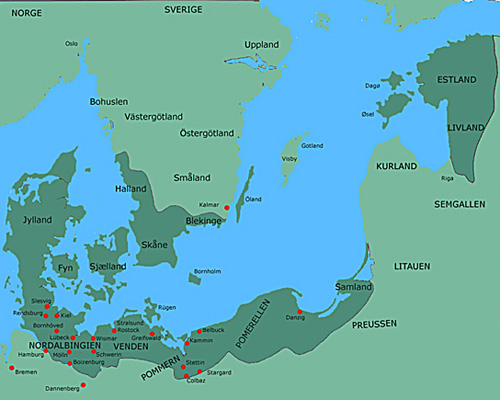| Middelalder

| | Kommunikationen i Middelalderen skal ses i lyset af Danmarks rolle som den dominerende østersømagt.
Skånes centrale placering betød bl.a. at Danmarks kirkelige centrum blev placeret i Lund og at Skånes sydlige handelsplads, Skanør ved Falsterbo, blev et internationalt, økonomisk kraftcenter. Skibene gik i pendulfart. |
Østsjælland og Skåne: Et fælles kulturområde
Kulturlandskabet på den skånske side består af tre hovedtyper: Slettebygden, der fortrinsvis befinder sig på de flade strækninger langs kysten i syd og vest, skovbygden i den nordøstlige del af landskabet op imod Småland og omkring åsene. Imellem disse to typer ligger risbygden, der bl.a. er dominerende i Helsingborgområdet. Risbygden er karakteriseret ved en slags skovlandbrug, meget lig dyrkningsmønsteret i Nordøstsjælland.
Rød-endelsen findes i rigt mål i Skåne og Nordsjælland, men derimod ikke i det sydvestlige Sjælland. Meget tyder på at der har eksisteret to mere eller mindre adskilte kulturområder på Sjælland, opdelt i en henholdsvis vestlig og østlig, som orienterer sig mod det skånske område.
Kontakten imellem Sjælland og Skåne har været tæt i en tidsalder, hvor Øresund ikke skilte landskaberne, men tværtimod fungerede som en bekvem og hurtig færdselsåre. Adam af Bremen, der laver den første beskrivelse af området, konstaterer i 1070 at man fra Sjælland mange steder kan sejle over til Skåne.
Kortest er afstanden dog ved Helsingborg, hvor den smalleste del Øresund benævnes Halsen og befolkningen der kaldes halsinger. En gængs tolkning af stednavnene Helsingør og Helsingborg går på at det betyder helsingernes borg og øre, dvs. en landtange, der strækker sig ud i vandet. Andre forskere tolker endelsen -ør som: en stenet strandbred. Som fx i stednavnene Dragør og Skanør.

Tre landskabstyper | 
Udflytterlandsbyer | 
Bosættelser i Skåne |
Skånemarkedet
Selvom byudviklingen var beskeden set i forhold til hansestædernes vækst havde det danske rige dog afgjorte fordele af væksten i landbrugsproduktionen og sildefiskeriet, der om efteråret forgik langs Øresunds kyster. Især Skanør-fiskeriet og det dertil knyttede Skånemarked var af stor økonomisk betydning for den danske kongemagt. Skanør og Falsterbo var dog helt specielt ved sin tidsbegrænsede aktivitet, hvor fiskeriet foregik i efterårsmånederne og markedet knyttede sig hertil. I denne periode boede og arbejdede udlændinge og lokale på området.

Skånemarkedet | 
Sildefiskeri | 
Skanør kirke | 
Borganlæg |
Sildefiskeriets betydning
Allerede i 1000-tallet er der beretninger om store mængder af sild i Øresund, men først i katolsk tid med kødløse fredage og fastedage og nedsaltning med salt fra Lüneburger Heide bliver silden den vigtigste eksportvare. I gode år i 1300-tallet kunne der årligt produceres og eksporteres op til 300.000 tønder årligt og det anslås at omkring en tredjedel af den danske krones indtægter stammede fra indtægterne af skånemarkedet og det bliver da også det vigtigste marked i Øresunds- og Østersøregionen.
Hansaens interesser.
Hanseaternes magt over østersøhandelen aftager omkring år 1300. Allerede i 1250 havde de første ummelandsfarere, folk fra Nederlandene og England der sejlede ummeland, dvs. nord om Jylland og ned igennem Sundet for at komme ind i Østersøen, vist sig på Skånemarkedet. Hanseaterne anvender deres kontrol over Skånemarkedet i perioden 1368-85 til at udelukke omlandsfarerne, men disse kan nu med de mere veludviklede skibstyper sejle direkte til destinationer langt inde i Østersøen. Desuden finder hollænderne ud af at fiske sild i Nordsøen, således at man helt kan undvære Skånemarkedet. Hertil kommer endelig at sildefiskeriet i Sundet kulminerer hen imod slutningen af 1300-tallet.
Handel og byer
Helt tilbage i forhistorisk tid har der fundet handel sted imellem Norden og Sydeuropa og i sen jernalder og tidlig vikingetid er bl.a. rav, pelsværk og slaver blevet solgt og byttet for luksusvarer som f.eks. glas sydfra.
I 700–tallet blev handelen imellem Middelhavet og Nordeuropa bl.a. formidlet via Frankerriget, men da det bukker under i starten af 800-tallet og araberne erobrer store dele af middelhavsområdet kommer Norden i vikingetiden til at spille en fremtrædende rolle i både nord-syd og øst-vest handelen. I det sydlige Skandinavien bliver Hedeby i Sønderjylland et fremtrædende handelscentrum, mens det længere øst og nordpå er Gotland og Birka i Sverige.

Handelsveje |
Skibstyper
Først og fremmest var det vikingernes skibsteknologi der fra omkring år 800 sikrede dem en fortrinsstilling i østersøhandelen. Man må forestille sig at stormænd og bønder udrustede skibe til togter i langskibe der kunne laste ca. 9 tons.
De senere udviklede, men også klinkbyggede skibe af knartypen, som man også anvendte til sejlads på Nordatlanten, kunne laste omkring 20 tons.
I starten af perioden har det nok været vanskeligt at skelne imellem plyndrings- handels- og kolonisationstogter, men på overgangen til middelalderen omkring år 1050 spiller handelen en mere fremtrædende rolle. Det sidste især takket være den nye skibstype koggen, der med sit høje kravelbyggede skrog kunne laste op imod 30 ton, og omkring år 1200 helt op imod 200 tons.

Kogge og Knar | 
Knar | 
Kogge. | 
Malmøkoggen | 
Model |

Hork |
Varetyper
Fra omkring dette tidspunkt begynder handelen også at skifte til mere dagligdags varer, såsom korn, fisk og kød, som bl.a. stammer fra den overskudsproduktion som de nye dyrkningsmetoder tilvejebringer. Disse produkter kunne afsættes i de bysamfund, som i løbet af 11- og 1200-tallet blomstrer op i Nordtyskland. Disse hansestæder, som de efterhånden benævnes, kommer i den efterfølgende tid til at beherske store dele af handelen på Østersøen i kraft af organisatorisk og teknologisk overlegenhed. |